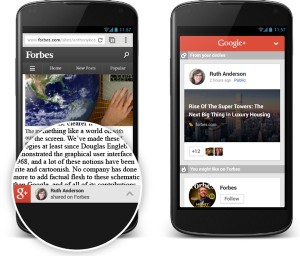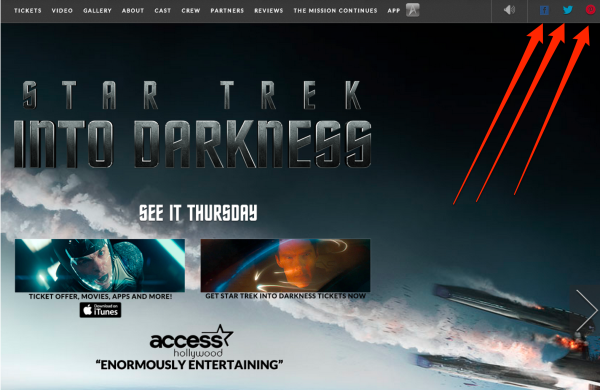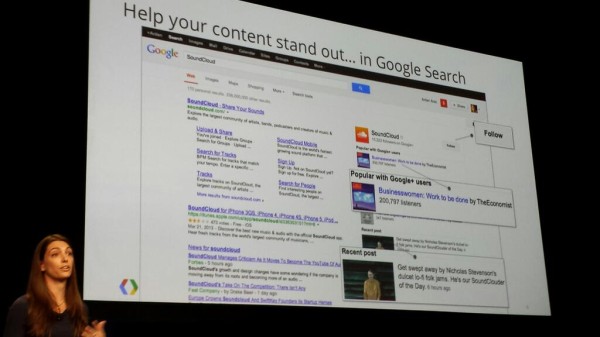Google: “Game Changing” Features Will Boost Google+ Adoption
Nearly two years after its launch, Google is still dealing with people who question why they should bother with Google+. But in recent weeks, the company has released what it considers “game changing” features that it feels will better enlist both marketers and developers to embrace its platform. “You’re now seeing us put out, on […]

“You’re now seeing us put out, on a constant drumbeat, tools and capabilities for developers and marketers that I think are game changing, that they may not get anywhere else,” said Seth Sternberg, product management director for the Google+ Platform, when meeting yesterday with a small group of reporters at the Google I/O conference.
I’d asked Sternberg about adoption because even in the middle of the biggest gathering of people who seemingly want to adopt anything Google pushes out, it was clear developers and others still don’t get what Google+ is supposed to be or why they should use it.
Making The Case, Because It Clearly Needs To Be Better Made
This came up in several of the sessions I attended at Google I/O, most notably in the fireside chat with the Google+ platform team yesterday. There, you had someone who represents celebrities asking for real numbers or stats that he could go back to prove the value to being on Google+, because his clients didn’t get it. They get Facebook. They get Twitter. They don’t get Google+.
As he put it, “If I’m going to tell J.J. Abrams give me a million bucks for a hangout, he’s going to say what value do I get?” By the way, this person didn’t say he actually represents Abrams, just that he works with that type of client.
But Abrams is a great example. At Google I/O, Google talked about how cast members from the new Star Trek: Into Darkness movie by Abrams did a hangout on Google+. They did. But only because big Google+ user NASA arranged it. As far as Abrams, or at least the official Star Trek movie site is concerned, pointing people to Google+ doesn’t make the cut:
Icons for Facebook, Twitter and Pinterest are listed on the official site but not Google+. The movie does have an official Google+ page. It just doesn’t promote that page nor, apparently, can be bothered to update it to the fact that the movie has actually reached theaters:
Clearly, Google has a lot of work yet to do in showing the value of Google+ to big brands, as well as business of all sizes.
Rank Better On Google With Google+
Let me suggest the first value proposition Google needs to explain loudly and clearly about why you want to be on Google+, which is:
Being on Google+ means you’ll rank better on Google
Google has generally underplayed this aspect. In fact, if you talk to the Google Search folks, they’re down right negative about the idea that Google+ provides any type of ranking boost.
But the Google Search people are talking about non-personalized search. When people are logged in — which more and more are these days — results are much more customized, personalized, tailored to who you are. And as I wrote in 2011, who you’re friends with on Google+ leads to better rankings.
You’d think this simple value proposition alone would cause people to get it, get why they need to pay attention to Google+. Everyone understand the value of ranking well on Google. That’s easy. And yet, this value gets lost.
I think Google’s finally getting it, however. In another session at Google I/O, Grow Your Audience With Google+, Google+ product marketing manager Amy Walgenbach repeatedly stressed the benefits Google+ brings to brands for Google Search.
SoundCloud joined and gained an entire area to the right of the regular search results that it wouldn’t have had before, an “incredible amount of real estate,” she said:
For generic searches — when people are searching not for a company by name but perhaps for a topic that the company might hope to appear for — Google+ can cause brands to appear when they wouldn’t have before:
In the example above, for a search on “summer cocktail,” the first three results are personalized — listings that have been boosted to the top of the page based on Walgenbach’s connections on Google+.
Without those, Martha Stewart would still rank tops, but the Food Network and Marie Claire wouldn’t show on the first page at all (as I can tell when I do the search logged out). FYI, for me, when logged in, I get a page from the Los Angeles Times in the top results because I follow them on Google+.
In addition, Walgenbach said even YouTube results are impacted. “The only reason this Ford video shows up on YouTube is because I follow them in Google+,” she said, when showing one example of the “Watch to Watch” feature:
Her presentation was probably the strongest I’ve ever heard Google overtly push the Google+ to increased Google Search visibility connection.
It’s something that search marketers themselves have understood and explained to others for ages. But Google’s shyness over the advantage might finally be easing off in the face of so many people still not being convinced about the social network.
Getting Interactive With Posts
Since increased search visibility hasn’t been convincing enough to date, what are those new game changing things Sternberg is talking about?
One is Google Interactive Posts, which allow people to drive actions beyond just clicking to read more. Sign-up! Download! Subscribe! Those are among the 100 actions that can be integrated with a post:
This was a big change. Did you catch it, when it came out last February? It sure got past us. Best I can tell, it got past all the major tech blogs. That’s largely because Google did a pretty poor job announcing it.
Ironically, I spotted it by seeing a great post last month by Mike Armesen of SwellPath on Google+ about it. Read his post below, as well our our follow-up one, to learn more about the feature:
- Get Up and Running with Google+ Interactive Posts
- How Google+ Interactive Posts Push CTAs & Deep Linking Directly Within A Post
Google+ Sign-In
Many did hear about the Google+ Sign-In launch that happened in February. That’s probably because the big news really was how Google — in my view — heavily positioned it as a “spam free” alternative to Facebook.
At Google I/O, Google was downplaying the spam-free aspect and touting how using its sign-in can better connect publishers and companies to their readers and users plus, in turn, have data that can flow out to help within Google Search.
There’s a lot to unbundle within Google+ Sign-In, because how you use it can vary so widely. App makers may understand how their most popular apps can appear in Google Search because Google talked about bringing “app activities” to search last month, as our story below covers more:
But if you’re a publisher, you might overlook the opportunity for Google+ Sign-In to understand what your readers like most and flow that out as top recommendations. I think Google has plenty of work to do here to better communicate this value, perhaps with more stories of how non-app developers are using it.
There was a publisher pavilion area at Google I/O area, but they looked mostly bored when I wandered through. Put them on stage!
There also remains another challenge. It’s also easy to show Facebook recommended posts on a publisher site. We do it right here, and there’s no “Facebook Sign-In” required to make it happen. You just need a Facebook page.
Google Content Recommendations

These only work for mobile, for now (where mobile to Google means Android and iOS — Windows Phone, as usual, gets left out). But at Google I/O, Sternberg and others repeatedly stressed that mobile is where they are most needed, for now.
There’s a huge bounce rate on mobile content, Sternberg said. People read one article that they click to from email, Twitter, Facebook, Google+ or however they reach it, then move on. Google+ Content Recommendations have, in testing, greatly increased the chance they’ll stay on a site and read more.
Google Hangouts More Confusing?
Google also continued to tout the value of doing Hangouts. But are these now Hangouts On Air? Or Google+ Hangouts versus Google Hangouts? Because now we do have Google Hangouts, adding more confusion into a Google brand that’s already started with confusion when no one knows if its a social network or a “layer” much less how to handle punctuation after that damn plus symbol in Google+.
Google Hangouts, announced at Google I/O, is the new name to unify Google’s various messaging applications, as The Verge explains well in a story this week. Unified except for Google Voice, that is, which seems to be floating out in a messaging netherworld.
Before this, Google Hangouts was that thing you did on Google+ itself, video calling with individuals, and Google+ Hangouts On Air a way to broadcast to a larger audience.
It’s the “On Air” stuff that Google focuses so much attention on when promoting Google+, big brands or celebrities doing a video broadcast. But some were doing regular Google+ Hangouts before, where these weren’t livestreamed. With the messaging realignment, now just sending an instant message to someone you know is technically a Google Hangout.
That gives us a broad world of Google Hangouts, which in turn encompasses Google+ Hangouts, which in turn encompasses Google+ Hangouts On Air. Phew. And Google wonders why people might not understand what Google+ is?
What Is Google+?
That leads back to the “what is Google+?” question that repeatedly came up during the sessions I attended. A layer, a platform, a destination. Stuff we’ve all heard before, and stuff that’s all true — and stuff that still doesn’t answer the question.
Much of this confusion is down to legacy. When Google+ launched, Google was desperate not to be seen as launching a “me too” social network that would get compared to Facebook, plus it honestly had a vision of Google+ as being more than just a social network.
For me to explain it what Google+ is, let me rephrase the question. “What is Facebook?”
That’s an easier question to answer. Facebook is a social networking site, one that allows you to socially connect in various ways ranging from sharing articles, to posting pictures to friends, to sending messages, including some methods that happen off Facebook itself. Publishers and others understand there’s a large audience there and can visibility see the value in the traffic Facebook sends or brand lift it creates.
All of Facebook’s products that allow you to do this carry the Facebook name, are part of the Facebook brand. That’s also why reasonably, while Google’s been weird about its active user figures in the past, it can fairly argue that if people who use Gmail once per month on Google aren’t counted as “Google+ active users,” then why are people on Facebook who use Facebook to email maybe only once per month counted as active users there?
Google’s not just a social network. It’s really whatever it wants to be, a company that exhibits no real boundaries. But maybe it’s time for Google+ to be the specific Google social network name while Google-something-else becomes used as the name for the “social spine” or “layer” of Google stitching social into all of its products.
Consider in December that Google’s social chief Vic Gundotra told me that “Google+ is Google” but at the Google I/O keynote this week he said, “We think we just put the Google into Google+.” Which is it? They’re not one-and-the-same.
There is a destination site, a hub of social activity where people do some very overt social things. Maybe that needs to be Google+, and there’s a value proposition to being on that.
As for the “layer” or “spine,” maybe there needs to be just Google — a Google Sign-In, for example, that works with Google+ but also elsewhere at Google, that when it carries the Google name rather than the Google+ name, perhaps isn’t as easily dismissed by some. A Google Account, rather than a Google+ Account — and you decide what that Google Account uses (which is actually how things work now).
Renewed Outreach

“This is all reasonably new. We want to reach out and engage our customers in our community, and we’ll really begin that in earnest the next few months, and we very much welcome people getting in touch asking how we can help.”
Opinions expressed in this article are those of the guest author and not necessarily MarTech. Staff authors are listed here.
Related stories






